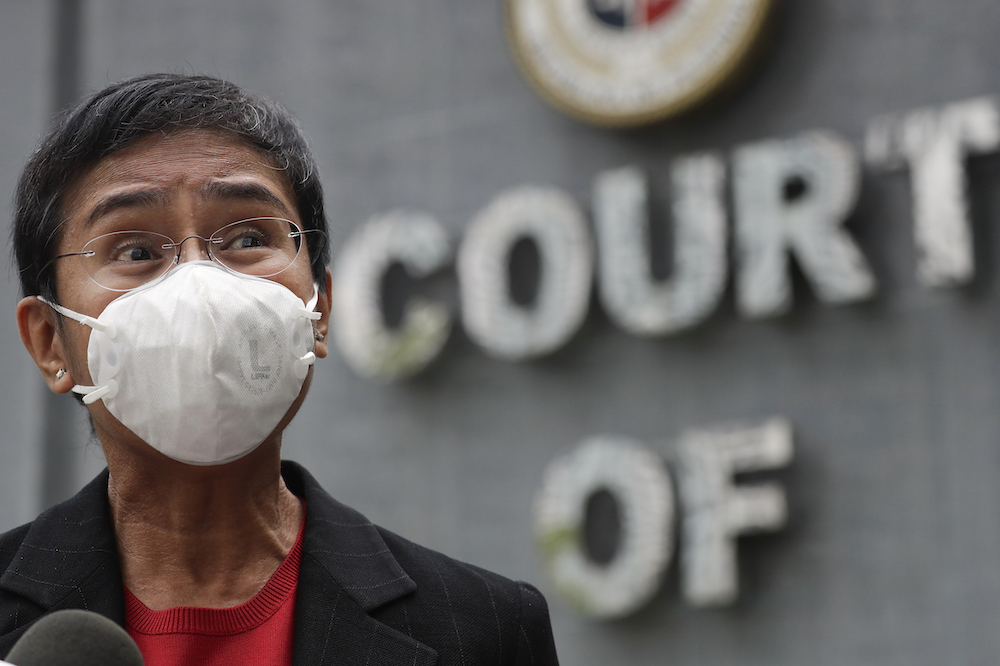
Rappler CEO and Executive Editor Maria Ressa, outside the Court of Tax Appeals in Metro Manila on March 4. Ressa, a journalist critical of Philippine President Rodrigo Duterte, faces tax charges while coping with a years-long campaign of doxxing, death threats, racist, and misogynistic harassment online
By now, those of us working in news media know what online violence looks like. It manifests as sexist abuse, threats to life and limb, doxing and trolling. Recent well publicized incidents include attacks against New York Times media reporter Taylor Lorenz, who was targeted after being singled out by Fox’s Tucker Carlson; Brazilian journalist Patricia Campos Mello, who was trolled by Brazilian president Bolsonaro’s son; and Rappler’s Maria Ressa, whose trolling by President Duterte and other government officials in the Philippines is depicted in the documentary “A Thousand Cuts.”
What is not well understood is the impact on mental and physical health, its consequences for a free society, and how to protect the journalists who are targeted.
Online violence has the same impact as violence experienced offline.
The epidemic of online violence has serious, negative consequences on how news stories are covered, or not covered. Journalists have told us that they often make calculations about whether to report a story – and carefully consider the language they use if they choose to report it – based on the suspected amount of backlash they may receive when the story is published.
In addition to self-censorship and its threat to press freedom, study after study, including the International Women’s Media Foundation (IWMF) and TrollBuster’s report, “Attacks and Harassment: The Impact on Women Reporters and their Reporting,” have shown that online violence is contributing to the departure of early-career women journalists, which creates two long-term impacts on journalism.
Firstly, without these voices, we may not be seeing critical reporting on women’s rights, LGBTQI+ issues, and more recently, political reporting and reporting on COVID-19; all beats targeted by trolls. Secondly, the departure of younger women and female journalists of color who are choosing to forego a career in journalism perpetuates the gross under-representation of women at all levels of the news. This hole diminishes a diverse community of journalists that is essential for broad and complete reporting.
But it’s not just journalists who are targeted by online violence. All participants in the media are attacked. For example, our organization was targeted by the very trolls we speak out against for using the word “violence” to describe online attacks. We use the word intentionally and will continue to do so to convey the real-world impact that this pernicious attempt to silence has, particularly on women, BIPOC and AAPI journalists. Research shows that journalists who experience online attacks experience real trauma and exhibit symptoms similar to PTSD.
While these attacks have been a part of many journalist’s day to day life for years, journalists and media organizations are still not well-equipped to combat them. For years, the problem has been perceived as inevitable; simply, the cost of doing business online. It also has been diminished by journalists themselves, who feel guilty speaking out when their peers are being physically attacked or imprisoned.
However, increased political polarization coupled with increased screen time during the pandemic has exacerbated the problem. Add to that the growth of organized, misogynist trolls, who join attacks strategically levied by those who consider journalists a threat, and we find the proliferation and consequences of the attacks escalated to the point that those who are targeted can no longer withstand the onslaught.
A culture shift is needed in the media industry to take online violence as seriously as physical violence. Media organizations must employ resources, strategies, and risk assessments to address online attacks resulting from both their journalists’ coverage and based on how their journalists identify. Newsrooms must support journalists before, during, and after online attacks occur, and they must proactively protect women, BIPOC, AAPI, and LGBTQI+ journalists who are disproportionately targeted.
To support journalists and newsrooms, with the support of Craig Newmark Philanthropies, the IWMF developed the Coalition Against Online Violence, which offers journalists collective support, bolstering their digital security and empowering the news media at-large to keep their employees safer online. The coalition’s corresponding Online Violence Response Hub will serve as a resource for those being targeted as well as those seeking to support them.
The IWMF’s digital security expert, Ela Stapley, offers the following advice.
For newsrooms:
- Create a culture where media workers feel comfortable discussing, reporting, and supporting each other with issues related to online violence.
- Work with staff to identify key points of contact within the organization who journalists can approach to talk about abuse. Encourage peer support networks within the newsroom. The International Press Institute highlights models by the BBC and Reuters as successful ways of supporting staff.
- Recognize that women, BIPOC, AAPI, and LGBTQI+ journalists are disproportionately targeted and that they may not come forward to report abuse without encouragement and a support network in place.
- Establish guidelines and policies to support journalists and ensure that they are known to staff. The International Federation of Journalists has created this draft policy document for newsrooms to consider.
- Sign-up staff to have their personal details removed from data broker sites. There are a number of services journalists can use, including Abine, DeleteMe, and Privacy Duck. These services vary in cost and a repeat subscription is needed to ensure that personal data is continuously removed.
- Raise awareness among journalists and editors that certain stories are likely to result in higher levels of online violence. Help journalists prepare for this by carrying out a risk assessment.
For journalists:
- Carry out a mapping exercise of your data online and take steps to remove or limit access to personal information that you are uncomfortable having in the public domain.
- Try and remove data online that can be used to verify your identity, locate you, or contact you. This can include your date of birth, your address, or your personal email. This information can be used by online abusers to harass and intimidate you. The New York Times has a thorough self-doxxing guide that walks people through securing their online data. The Committee to Protect Journalists has a helpful resource for U.S. journalists looking to delete their online information. PEN America has a comprehensive field manual that has advice for both journalists and newsrooms looking to learn more about online abuse and strategies to protect against it.
- Journalists should also consider signing up to get their details and the details of close family members removed from data broker sites. Common services include Abine, Delete Me and Privacy Duck.
- Use a password manager and turn on two-factor authentication to secure all accounts – not just accounts related to your journalism.
- Create a plan for dealing with online violence. Do a risk assessment for each story and identify the possible groups that might target you. This will help you be better prepared for dealing with online abuse, should it happen.
- Both journalists and newsrooms are encouraged to seek out extra resources for dealing with online violence. There is a wide range of support available from organizations that work to defend freedom of expression, internet freedom, and digital rights. All these resources will soon be available in one place on our Hub.
Create a peer-support network:
A peer-support network can be an essential resource for women journalists who are targeted by online abusers. Being subjected to online violence can be an isolating experience, so it’s important for media workers to have a community in the newsroom that they can contact. When creating a peer-support network, think about the following:
- Having trained members of staff to offer support and mentorship
- Creating a group chat on a messaging app where journalists can talk about abuse, share tips and resources, and let others know when they need support
- Reaching out to younger journalists who may not feel comfortable approaching more senior members of staff about abuse
Reuters and the BBC have further insights here.
In addition, journalists can take courses to inform themselves of steps they can take to create a safer online work environment. The IWMF and the Knight Center for Journalism in the Americas have a self-directed course on strategies for dealing with online harassment. The Global Cyber Alliance has an online course that teaches cyber risks for journalists. And the IWMF and Free Press Unlimited have designed two courses for journalists that give practical advice for protecting online privacy as well as giving an insight into who abusers are and how they operate.
Failure to support journalists facing online violence will only increase the lack of diversity and representation already prevalent in the news industry. To prevent that, and to support colleagues facing harassment and abuse, media organizations and journalists should use all the tools available to us to combat it.
Elisa Lees Muñoz is Executive Director of the International Women’s Media Foundation.

